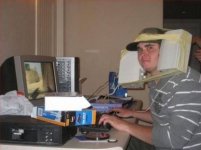Right now, I'm looking at two options for a TMW concept:
1) Try to use an additional driver to "steer" the off-axis response (really, create a cancellation/lobe so the off-axis response at just the bounce angle is at a significantly reduced output). I'm not sure if this is possible but I'm thinking I'll try to figure out VituixCAD for this.
2) Put an absorber/diffuser in the bounce path. This would seem to be the easiest option but it's more wide-band than I would like and will look physically large and ugly (basically an absorbing bucket...)
The one option that I do not wish to pursue, in my particular situation, is to put the woofer right down at desk level, because that increases the c-c distance to the midrange beyond the limit I've set. I want the tweeter to be at approximate eye/ear level, with midrange as close as possible to the tweeter.
Thoughts?
1) Try to use an additional driver to "steer" the off-axis response (really, create a cancellation/lobe so the off-axis response at just the bounce angle is at a significantly reduced output). I'm not sure if this is possible but I'm thinking I'll try to figure out VituixCAD for this.
2) Put an absorber/diffuser in the bounce path. This would seem to be the easiest option but it's more wide-band than I would like and will look physically large and ugly (basically an absorbing bucket...)
The one option that I do not wish to pursue, in my particular situation, is to put the woofer right down at desk level, because that increases the c-c distance to the midrange beyond the limit I've set. I want the tweeter to be at approximate eye/ear level, with midrange as close as possible to the tweeter.
Thoughts?
I'd think about using a stacked line array, such as two- or three-high air-motion transformers (AMTs)--which have outstanding transient performance and consistent polar coverage--at a very economical price for line arrays. This will control the vertical coverage angle quite effectively down to about 550 Hz:

Then add mid-woofers top and bottom in a D'Appolito configuration.
Voila! no more problems with floor/desk bounce. You can design in the lowest frequency of beam width control by spacing the mid-woofers top and bottom at about half the wavelength at the lowest frequency you want to control (200 Hz...?). That would be about 33 inches center-to-center vertical spacing. Below that frequency, you're into the sparse mode region of the listening room where polar control no longer has a lot of meaning except to control the point at which the woofers lose both horizontal and vertical directivity, implying positioning the loudspeakers in half space or quarter space to support the bass response on down to the free-air resonance of the woofers. That would look something like this, with dual-high AMTs, likely in a smaller package than that shown below:

Chris
Then add mid-woofers top and bottom in a D'Appolito configuration.
Voila! no more problems with floor/desk bounce. You can design in the lowest frequency of beam width control by spacing the mid-woofers top and bottom at about half the wavelength at the lowest frequency you want to control (200 Hz...?). That would be about 33 inches center-to-center vertical spacing. Below that frequency, you're into the sparse mode region of the listening room where polar control no longer has a lot of meaning except to control the point at which the woofers lose both horizontal and vertical directivity, implying positioning the loudspeakers in half space or quarter space to support the bass response on down to the free-air resonance of the woofers. That would look something like this, with dual-high AMTs, likely in a smaller package than that shown below:
Chris
Here's the uncorrected SPL response and spectrogram of dual-stack ESS AMT-1 with wings in-room at 1 m (note the resolution of the vertical scale is 2 dB/division):
https://community.klipsch.com/index...eritage/page/16/&tab=comments#comment-2452137
It's actually pretty spectacular performance. The larger 12" wings give better performance, but you can also see the performance of 7" wings.
Chris
https://community.klipsch.com/index...eritage/page/16/&tab=comments#comment-2452137
It's actually pretty spectacular performance. The larger 12" wings give better performance, but you can also see the performance of 7" wings.
Chris
Calculate path lenght difference between reflection through the desk vs direct sound. This determines wavelenght (~1/2wl) you start the combiltering happen. If you don't know this yet you should utilize the knowledge and design for it. You can also find put at which angle the reflection happens.
Basically, low frequencies are not affected by bad sound, dips and peaks due to interference of the reflected sound causes. When wavelenght is long (bass) only constructive interference happens, but anythin above 1/2wl and up will have interference. Hearing system seems to be able to ignore combfiltering on very high frequencies. You can possibly control directivity so that there is considerable attenuation towards reflection zone as Chris suggests, but there might be other tricks to complement.
For example flip your speaker upside down to get the path lenght difference down. Highest highs might not benefit too much but the mid would (depends on the path lenght difference). Tilt the speaker up towards ears to increase angle towards reflection zone on the desk for less sound no matter which dispersion control method you utilize. Use some kind of dispersion control. Most likely it is a waveguide or long transducer/array ad Chris suggests. MTM could help as long as it narrows dispersion on problematic bandwidth.
On a desk one might stay relatively still, especially if you are gaming or working. In which case all drivers could be at the boundary, speaker laid on its side.
Many ways to go at it, depending on details how you wanna do it.
Anyway, nice fun project!
Basically, low frequencies are not affected by bad sound, dips and peaks due to interference of the reflected sound causes. When wavelenght is long (bass) only constructive interference happens, but anythin above 1/2wl and up will have interference. Hearing system seems to be able to ignore combfiltering on very high frequencies. You can possibly control directivity so that there is considerable attenuation towards reflection zone as Chris suggests, but there might be other tricks to complement.
For example flip your speaker upside down to get the path lenght difference down. Highest highs might not benefit too much but the mid would (depends on the path lenght difference). Tilt the speaker up towards ears to increase angle towards reflection zone on the desk for less sound no matter which dispersion control method you utilize. Use some kind of dispersion control. Most likely it is a waveguide or long transducer/array ad Chris suggests. MTM could help as long as it narrows dispersion on problematic bandwidth.
On a desk one might stay relatively still, especially if you are gaming or working. In which case all drivers could be at the boundary, speaker laid on its side.
Many ways to go at it, depending on details how you wanna do it.
Anyway, nice fun project!
Last edited:
To demonstrate, here is path length difference if listening distance was 1m, speaker was 50cm above the desk as well as if the ear is 50cm above the desk. I don't know your numbers so this is just an example. Path length difference is 414mm and here is the interference due to that.
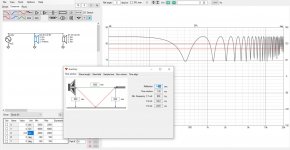
Now, lets get the speaker (driver) closer to desk, to 10cm above the desk. Ear stays at 50cm above the desk. Now the path length difference is only 95mm and the combfiltering goes up where the directivity is a lot easier to control than with low frequencies at few hundred hertz. It requires a lot smaller structure to control high frequencies than low since the structure needs to have sufficiently large in relation to wavelength to have control over it.
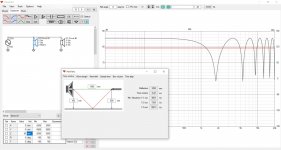
Now, if you tilt the speaker and/or have some dispersion control so that the mids, above 1kHz were attenuated 20db towards the reflection zone on the desk you get this:
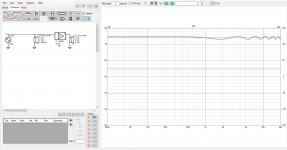
Here, in theory, we have mitigated the desk reflection pretty efficiently. I didn't check if something like this was physically possible to construct though, and if it would satisfy your SPL or other requirements. Perhaps just one 3" fullrange driver right against the desk tilted to your ears, and woofer somewhere within 1meter to that would do nicely? Well, missing the 20db attenuation towards reflection point, but the reflection would be around 3.5kHz, where the driver is already narrowing a bit:
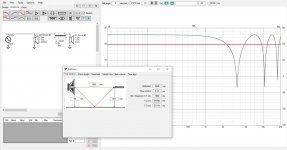
Hmm, perhaps the application is task for ribbon from desk up, or array of some sorts to get the attenuation towards reflection zone. I don't know. Would you like having chunk of glass fiber insulation there on the desk?😀 Anyway, try and use imagination to come up with a nice system, loads of fun!🙂

Now, lets get the speaker (driver) closer to desk, to 10cm above the desk. Ear stays at 50cm above the desk. Now the path length difference is only 95mm and the combfiltering goes up where the directivity is a lot easier to control than with low frequencies at few hundred hertz. It requires a lot smaller structure to control high frequencies than low since the structure needs to have sufficiently large in relation to wavelength to have control over it.

Now, if you tilt the speaker and/or have some dispersion control so that the mids, above 1kHz were attenuated 20db towards the reflection zone on the desk you get this:

Here, in theory, we have mitigated the desk reflection pretty efficiently. I didn't check if something like this was physically possible to construct though, and if it would satisfy your SPL or other requirements. Perhaps just one 3" fullrange driver right against the desk tilted to your ears, and woofer somewhere within 1meter to that would do nicely? Well, missing the 20db attenuation towards reflection point, but the reflection would be around 3.5kHz, where the driver is already narrowing a bit:

Hmm, perhaps the application is task for ribbon from desk up, or array of some sorts to get the attenuation towards reflection zone. I don't know. Would you like having chunk of glass fiber insulation there on the desk?😀 Anyway, try and use imagination to come up with a nice system, loads of fun!🙂
Oh yes! Drivers embedded into the table.
If you imagine how it would be made, turn the table up right position we would essentially have very wide baffle speaker. This would show quite bad diffraction from the baffle edge (table edge) though, making it not much better in terms of interference. This would apply to my idea of small driver close to table surface.. Hmm, maybe best option was to raise the speaker of from the table, very narrow vertical directivity aimed to ears. Very hard to mitigate effect of the table either way.. Headphones or glass fiber chunk on the desk could be the best after all 🙂 Pick your poison situation.
What if the speakers were at front edge of the table? This would make floor bounce instead. This could be tried with any existing tabletop speaker, ifthe sound is better speaker further back on the table or at the very front. Tilt to aim ears.
If you imagine how it would be made, turn the table up right position we would essentially have very wide baffle speaker. This would show quite bad diffraction from the baffle edge (table edge) though, making it not much better in terms of interference. This would apply to my idea of small driver close to table surface.. Hmm, maybe best option was to raise the speaker of from the table, very narrow vertical directivity aimed to ears. Very hard to mitigate effect of the table either way.. Headphones or glass fiber chunk on the desk could be the best after all 🙂 Pick your poison situation.
What if the speakers were at front edge of the table? This would make floor bounce instead. This could be tried with any existing tabletop speaker, ifthe sound is better speaker further back on the table or at the very front. Tilt to aim ears.
I already mentioned that having the woofer at desk level was a no-go, I'm trying to keep all the drivers as close together as possible (and at ear level) to emulate a point source.
As for what frequencies are involved, I've been using this to make the math easier: https://mehlau.net/audio/floorbounce/
As for what frequencies are involved, I've been using this to make the math easier: https://mehlau.net/audio/floorbounce/
Thanks Chris, will have to digest this a little more before I can respond properly.I'd think about using a stacked line array, such as two- or three-high air-motion transformers (AMTs)--which have outstanding transient performance and consistent polar coverage--at a very economical price for line arrays. This will control the vertical coverage angle quite effectively down to about 550 Hz:
Then add mid-woofers top and bottom in a D'Appolito configuration.
Voila! no more problems with floor/desk bounce. You can design in the lowest frequency of beam width control by spacing the mid-woofers top and bottom at about half the wavelength at the lowest frequency you want to control (200 Hz...?). That would be about 33 inches center-to-center vertical spacing. Below that frequency, you're into the sparse mode region of the listening room where polar control no longer has a lot of meaning except to control the point at which the woofers lose both horizontal and vertical directivity, implying positioning the loudspeakers in half space or quarter space to support the bass response on down to the free-air resonance of the woofers. That would look something like this, with dual-high AMTs, likely in a smaller package than that shown below:
Chris
Do you have measurements of the setup, ear height, table height, depth?I already mentioned that having the woofer at desk level was a no-go, I'm trying to keep all the drivers as close together as possible (and at ear level) to emulate a point source.
As for what frequencies are involved, I've been using this to make the math easier: https://mehlau.net/audio/floorbounce/
If you have the speaker about 50cm above desk you need very big device to keep sound of from the desk. Chris explained this well. If big system is not problem its fine.
If you want to keep it small I think you have to relax either requirement, height of transucers from desk or amount of desk reflection you want to reduce, or get rid of the desk 🙂 If it is WMT 3 way as you describe, woofer height doesn't matter much depending on crossover frequency. For example 200Hz is around 1.6m long so it is enough to have 40cm c-c between woofer to mid. Problem is the mid frequencies that have the bounce and resulting interference from the desk, that is hard to control. Very big device is needed.
If tweeter was 50cm above desk as the ear, like I explained earlier, you need MTM or array setup with c-c at least the same 50cm in order to get some attenuation towards the desk. Or horn whose dimensions are about 50cm. Quite big stuff. You get size down by moving the speaker closer to desk, below ear level, and tilt it towards ears.
You could make small WMT and put it ear level but it is gonna radiate sound towards the desk and have interference at ear.
Point source happens with coaxial, but again the coaxial would have to be in a big horn to keep radiation of the desk on mid frequencies, unless the coaxial was on the desk. You could do big multiple entry horn to achieve your goals, but you need big desk to accommodate those. The key is the height from the desk, the path lenght difference between the bounce and direct sound.
I'm sure youll find some kind of nice compromise between your requirements!
Last edited:
Why not use it to your advantage. Why are you trying to get the c-c distance small for a desk monitor anyway? Make c-c larger and create that lobe and aim the null at the desk so you get no reflection around the crossover region. Keep the woofer at desk level. Then you can move on to worrying about just the highest frequencies.The one option that I do not wish to pursue, in my particular situation, is to put the woofer right down at desk level, because that increases the c-c distance to the midrange beyond the limit I've set. I want the tweeter to be at approximate eye/ear level, with midrange as close as possible to the tweeter.
Personally I would swallow it and not obsess.
99% of Home Recordists just place cabinets at some convenient place, including over the desk or on some stand so they are at the right height, aim them where needed, and use them as-is.
Which is the not so perfect but realistic way to use them, there is only so much you can do at home.
Leave the detailed book perfect corrections to Million dollar "real" Studios and just enjoy your recording session 🙂 .
99% of Home Recordists just place cabinets at some convenient place, including over the desk or on some stand so they are at the right height, aim them where needed, and use them as-is.
Which is the not so perfect but realistic way to use them, there is only so much you can do at home.
Leave the detailed book perfect corrections to Million dollar "real" Studios and just enjoy your recording session 🙂 .
That is quite good advice. I tried some more simple tests with VCAD and it looks like it is not possible to make speaker that avoids the desk. The speaker needs to be tall, which makes interference even lower in frequency, demanding more height etc. 🙂 One can attenuate high frequencies towards the desk, but doing so makes the assembly so big there is low frequencies below the high control that will reflect. Problem is few db attenuation towards desk reflection zone does nothing to interference at ear, some serious attenuation is needed to have audible difference. -10db towards desk cuts interference about half making it still roughly +-3db. -20db would make interference roughly +-1db.
To really take out the desk use headphones, or take out the desk. Floor would be perhaps far enough so that direct sound dominates near field. You could make the desk acoustically not reflective, perhaps make shell out of some acoustically transparent metal mesh so you can keep stuff on it, and fill with acoustic damping. 3D printed meta material desk. Anyway, looks like best bet is to make the desk work acoustically, rather than obsess speakers avoid the desk.
Don't forget front wall! 😉 And floor and ceiling. Just bring the speakers close enough to ears to really get more direct than reflected sound, front of the desk. Can't beat headphones.
To really take out the desk use headphones, or take out the desk. Floor would be perhaps far enough so that direct sound dominates near field. You could make the desk acoustically not reflective, perhaps make shell out of some acoustically transparent metal mesh so you can keep stuff on it, and fill with acoustic damping. 3D printed meta material desk. Anyway, looks like best bet is to make the desk work acoustically, rather than obsess speakers avoid the desk.
Don't forget front wall! 😉 And floor and ceiling. Just bring the speakers close enough to ears to really get more direct than reflected sound, front of the desk. Can't beat headphones.
Attachments
Last edited:
I figured out the solution (at least, one that works for me, in theory). If I ever get around to building it (hopefully in a few years - dang parenthood) I will post photos.
It involves horizontally offsetting the midrange from the woofer, with an absorber underneath the midrange to attenuate just the small "cone spray" going to the desk bounce (cone, because my head will move around in a small region). Probably a chunk of melamine foam would be best. The reason for the horizontal offset is so that the absorber doesn't block the direct output from the woofer to the ear. Everything's still within 1/4 wl at crossover, steep slopes planned, so I'm not too worried about any weird horizontal off-axis impact.
FWIW I have about 55 cm ear height relative to the desk, with the mid (the important driver as far as desk bounce goes) at about 52 cm. There's a bit of wiggle room in the numbers but that's what I'm using right now.
It involves horizontally offsetting the midrange from the woofer, with an absorber underneath the midrange to attenuate just the small "cone spray" going to the desk bounce (cone, because my head will move around in a small region). Probably a chunk of melamine foam would be best. The reason for the horizontal offset is so that the absorber doesn't block the direct output from the woofer to the ear. Everything's still within 1/4 wl at crossover, steep slopes planned, so I'm not too worried about any weird horizontal off-axis impact.
FWIW I have about 55 cm ear height relative to the desk, with the mid (the important driver as far as desk bounce goes) at about 52 cm. There's a bit of wiggle room in the numbers but that's what I'm using right now.
My preference is to have all spacing under 1/4 wl at the crossover frequency. Does it make a difference? Probably not, but that's a design goal I've set for this particular concept. Steering the cancellation at the desk bounce angle is certainly a good way to do it, but of course you're looking at a larger hole in the power response.I'd think about using a stacked line array, such as two- or three-high air-motion transformers (AMTs)--which have outstanding transient performance and consistent polar coverage--at a very economical price for line arrays. This will control the vertical coverage angle quite effectively down to about 550 Hz:
Then add mid-woofers top and bottom in a D'Appolito configuration.
Voila! no more problems with floor/desk bounce. You can design in the lowest frequency of beam width control by spacing the mid-woofers top and bottom at about half the wavelength at the lowest frequency you want to control (200 Hz...?). That would be about 33 inches center-to-center vertical spacing. Below that frequency, you're into the sparse mode region of the listening room where polar control no longer has a lot of meaning except to control the point at which the woofers lose both horizontal and vertical directivity, implying positioning the loudspeakers in half space or quarter space to support the bass response on down to the free-air resonance of the woofers. That would look something like this, with dual-high AMTs, likely in a smaller package than that shown below:
Chris
As for the line array, I'm not a big fan of ribbons/AMTs unfortunately. I guess it's because I usually like to run my tweeters down relatively low before crossing to the mid/woofer.
I was actually thinking about a 3D printed metamaterial filter to acoustically notch out the null & following peak... the implementation of it just seems too annoying to deal with 🙂That is quite good advice. I tried some more simple tests with VCAD and it looks like it is not possible to make speaker that avoids the desk. The speaker needs to be tall, which makes interference even lower in frequency, demanding more height etc. 🙂 One can attenuate high frequencies towards the desk, but doing so makes the assembly so big there is low frequencies below the high control that will reflect. Problem is few db attenuation towards desk reflection zone does nothing to interference at ear, some serious attenuation is needed to have audible difference. -10db towards desk cuts interference about half making it still roughly +-3db. -20db would make interference roughly +-1db.
To really take out the desk use headphones, or take out the desk. Floor would be perhaps far enough so that direct sound dominates near field. You could make the desk acoustically not reflective, perhaps make shell out of some acoustically transparent metal mesh so you can keep stuff on it, and fill with acoustic damping. 3D printed meta material desk. Anyway, looks like best bet is to make the desk work acoustically, rather than obsess speakers avoid the desk.
Don't forget front wall! 😉 And floor and ceiling. Just bring the speakers close enough to ears to really get more direct than reflected sound, front of the desk. Can't beat headphones.
The best thing I did for my project studio setup was to move the bookshelf speakers from my desk to DIY stands. The latter are at the front edge of the table, so there's no direct desk reflections.
Huge difference in sound.
Desk reflections can be a problem, but there's another one: the desk itself acting like a large resonator.
After that I also used some vibration isolation at the speaker and stand interface for an incremental increase in SQ.
Huge difference in sound.
Desk reflections can be a problem, but there's another one: the desk itself acting like a large resonator.
After that I also used some vibration isolation at the speaker and stand interface for an incremental increase in SQ.
Good idea, I was thinking about that too but couldn't figure out a way to make it work. What's the listening (stereo angle) with that? Seems to me that it would be quite wide and/or the monitors would be very close to you, assuming a standard-sized desk.
As for the line array, I'm not a big fan of ribbons/AMTs unfortunately. I guess it's because I usually like to run my tweeters down relatively low before crossing to the mid/woofer.
Below 550 Hz? The shown dual AMT-1s with wings has the following on-axis performance (a link of which I provided above). Sensitivity is ~98-99 dB/2.83 V-metre.
I've not really heard of a "tweeter" going down much further. Directivity and impulse response are phenomenal. The dual-high AMT-1 configuration will keep floor bounce down to inaudible levels, while preserving horizontal coverage (full range) at 90 degrees included angle.
Chris
Last edited:
Ah, you're right. I was speaking generally, although the measured performance there seems exemplary. Would be nice to see measurements of the driver alone though.Below 550 Hz? The shown dual AMT-1s with wings has the following on-axis performance (a link of which I provided above). Sensitivity is ~98-99 dB/2.83 V-metre.
View attachment 1014941
I've not really heard of a "tweeter" going down much further. Directivity and impulse response are phenomenal. The dual-high AMT-1 configuration will keep floor bounce down to inaudible levels, while preserving horizontal coverage (full range) at 90 degrees included angle.
Chris
- Home
- Loudspeakers
- Multi-Way
- Best way to mitigate floor (desk) bounce in near-field PC monitoring setup?
